Accounting Assignment: Fair Value Measurement and Asset Valuation
VerifiedAdded on 2022/10/13
|7
|1269
|356
Homework Assignment
AI Summary
This assignment solution addresses key concepts in company accounting, focusing on IFRS 13 Fair Value Measurement, impairment testing, and cash flow analysis. It explores the application of fair value, the role of market participants, and exceptions to fair value measurement. The solution also examines the implications of using historical cost versus fair value for asset valuation, considering factors like depreciation and asset classification. Furthermore, it delves into the concept of Cash Generating Units (CGUs), discussing how to determine value in use and the importance of independent cash flows. The assignment provides a comprehensive understanding of financial reporting and asset valuation, offering insights into the practical application of accounting principles.
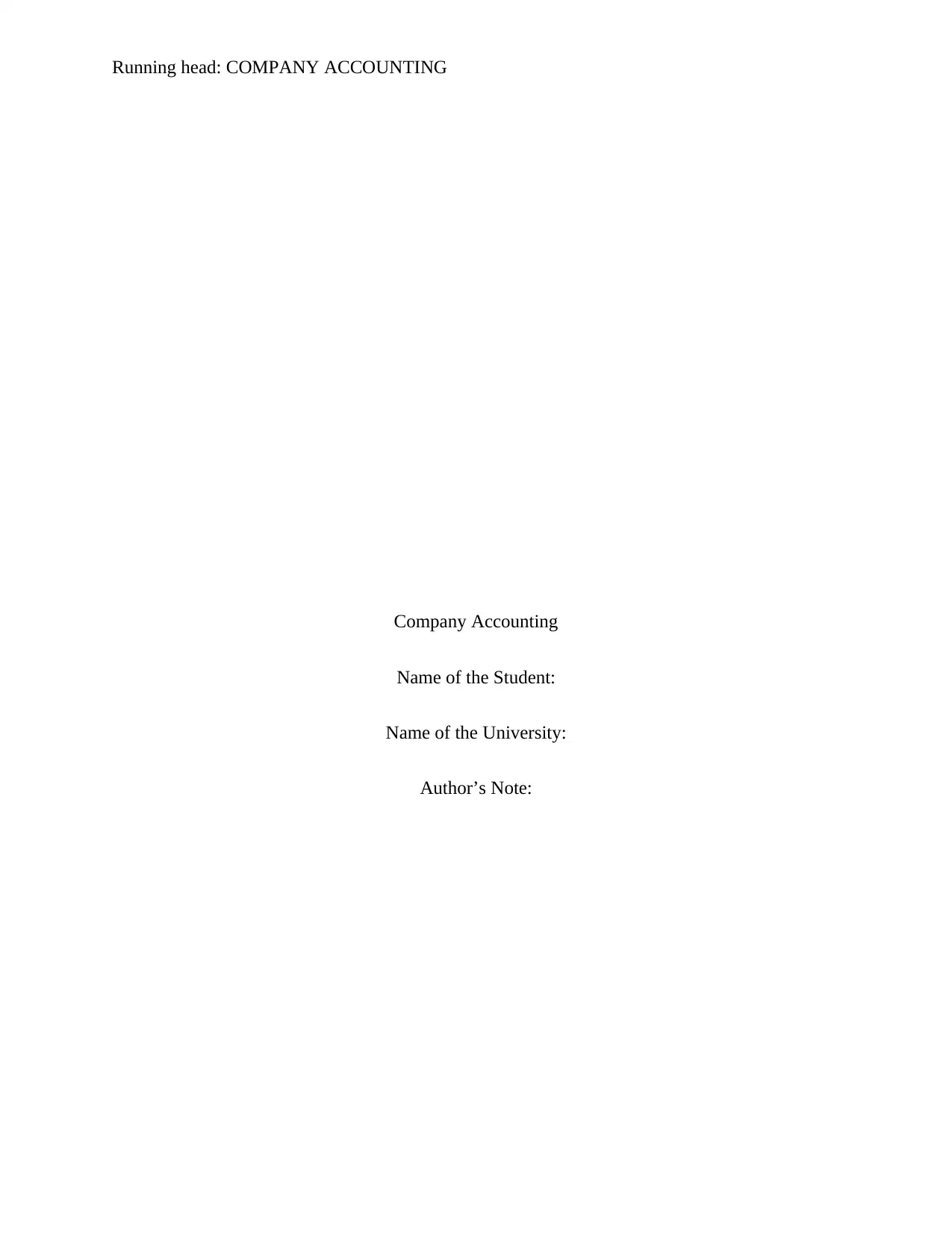
Running head: COMPANY ACCOUNTING
Company Accounting
Name of the Student:
Name of the University:
Author’s Note:
Company Accounting
Name of the Student:
Name of the University:
Author’s Note:
Paraphrase This Document
Need a fresh take? Get an instant paraphrase of this document with our AI Paraphraser
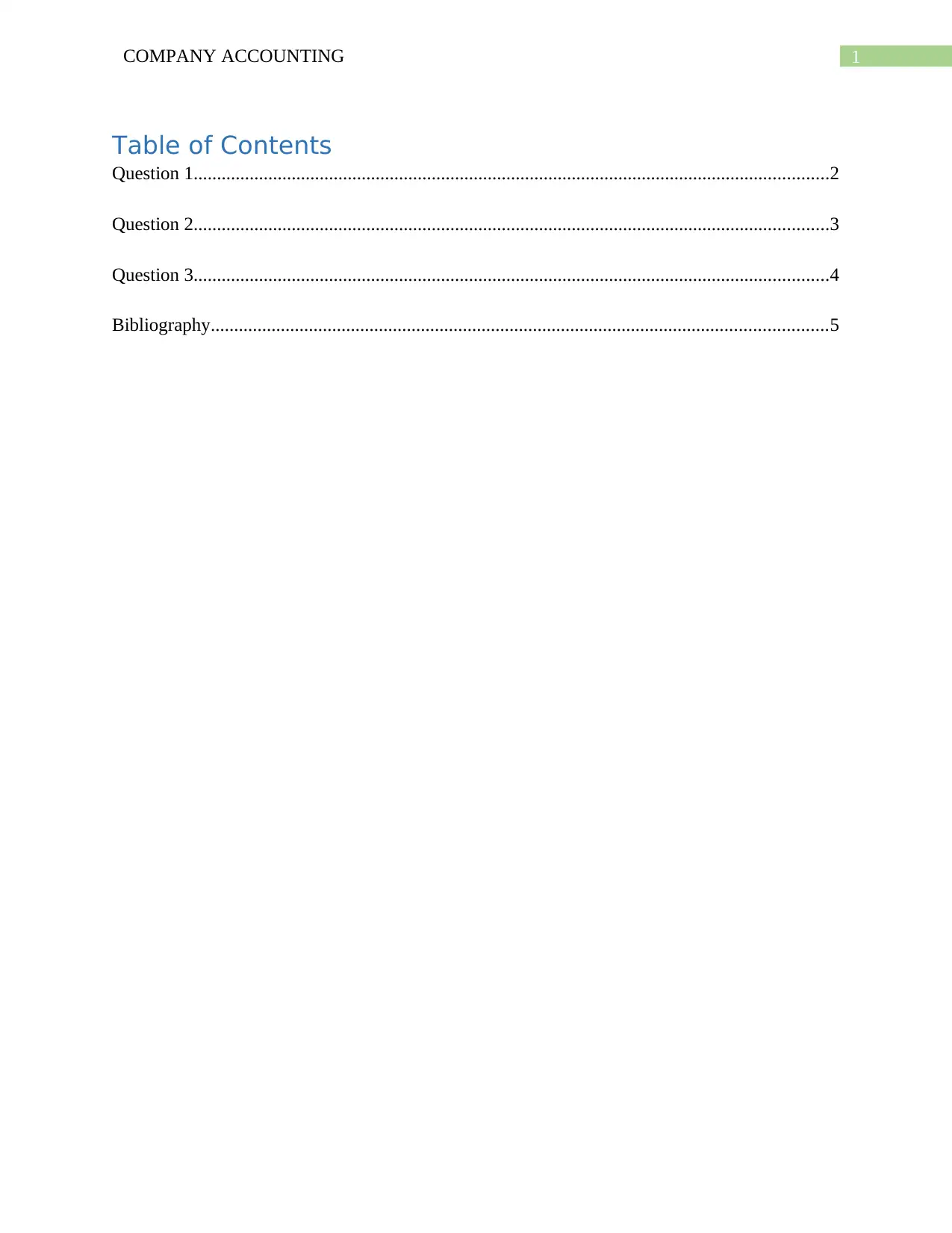
1COMPANY ACCOUNTING
Table of Contents
Question 1........................................................................................................................................2
Question 2........................................................................................................................................3
Question 3........................................................................................................................................4
Bibliography....................................................................................................................................5
Table of Contents
Question 1........................................................................................................................................2
Question 2........................................................................................................................................3
Question 3........................................................................................................................................4
Bibliography....................................................................................................................................5
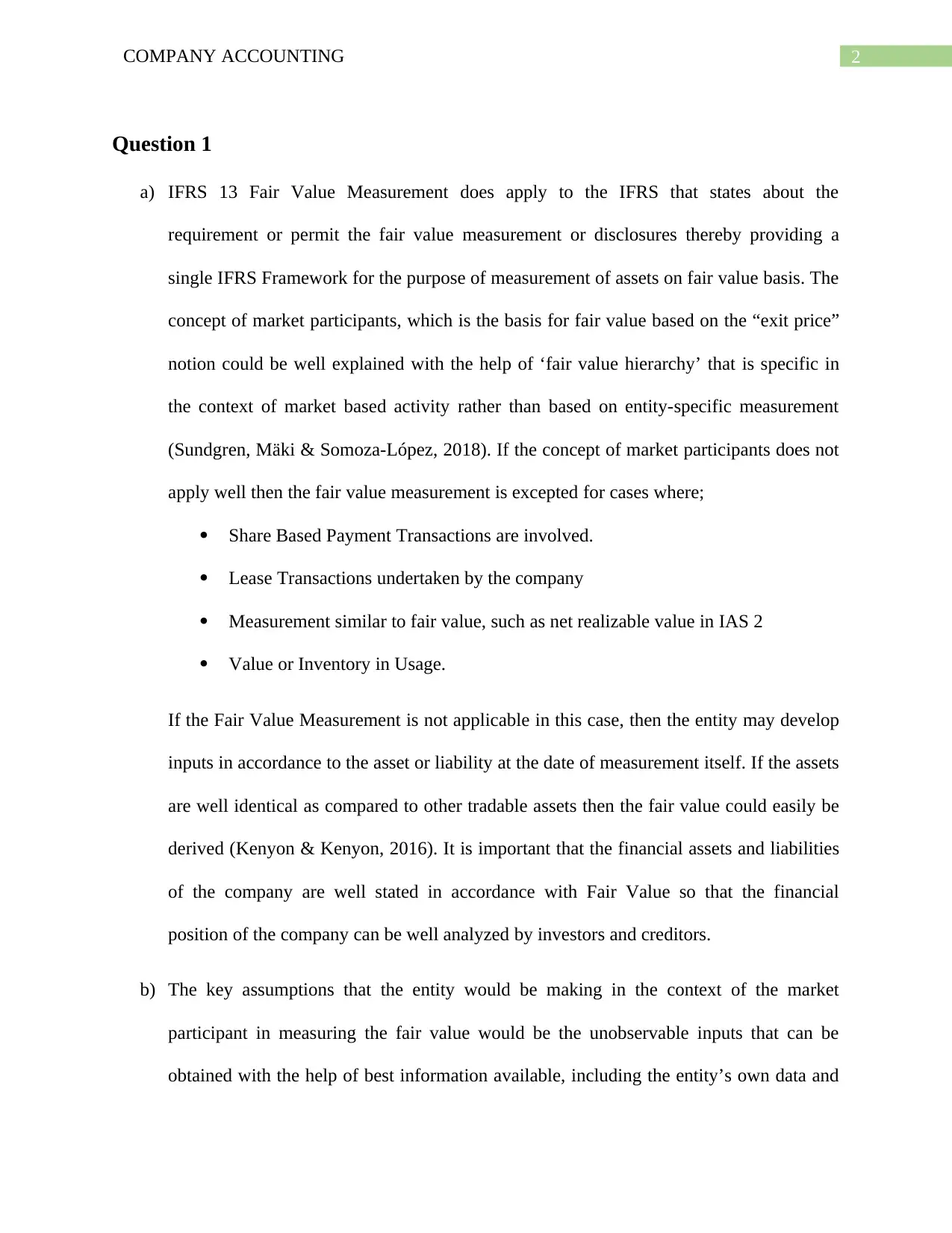
2COMPANY ACCOUNTING
Question 1
a) IFRS 13 Fair Value Measurement does apply to the IFRS that states about the
requirement or permit the fair value measurement or disclosures thereby providing a
single IFRS Framework for the purpose of measurement of assets on fair value basis. The
concept of market participants, which is the basis for fair value based on the “exit price”
notion could be well explained with the help of ‘fair value hierarchy’ that is specific in
the context of market based activity rather than based on entity-specific measurement
(Sundgren, Mäki & Somoza-López, 2018). If the concept of market participants does not
apply well then the fair value measurement is excepted for cases where;
Share Based Payment Transactions are involved.
Lease Transactions undertaken by the company
Measurement similar to fair value, such as net realizable value in IAS 2
Value or Inventory in Usage.
If the Fair Value Measurement is not applicable in this case, then the entity may develop
inputs in accordance to the asset or liability at the date of measurement itself. If the assets
are well identical as compared to other tradable assets then the fair value could easily be
derived (Kenyon & Kenyon, 2016). It is important that the financial assets and liabilities
of the company are well stated in accordance with Fair Value so that the financial
position of the company can be well analyzed by investors and creditors.
b) The key assumptions that the entity would be making in the context of the market
participant in measuring the fair value would be the unobservable inputs that can be
obtained with the help of best information available, including the entity’s own data and
Question 1
a) IFRS 13 Fair Value Measurement does apply to the IFRS that states about the
requirement or permit the fair value measurement or disclosures thereby providing a
single IFRS Framework for the purpose of measurement of assets on fair value basis. The
concept of market participants, which is the basis for fair value based on the “exit price”
notion could be well explained with the help of ‘fair value hierarchy’ that is specific in
the context of market based activity rather than based on entity-specific measurement
(Sundgren, Mäki & Somoza-López, 2018). If the concept of market participants does not
apply well then the fair value measurement is excepted for cases where;
Share Based Payment Transactions are involved.
Lease Transactions undertaken by the company
Measurement similar to fair value, such as net realizable value in IAS 2
Value or Inventory in Usage.
If the Fair Value Measurement is not applicable in this case, then the entity may develop
inputs in accordance to the asset or liability at the date of measurement itself. If the assets
are well identical as compared to other tradable assets then the fair value could easily be
derived (Kenyon & Kenyon, 2016). It is important that the financial assets and liabilities
of the company are well stated in accordance with Fair Value so that the financial
position of the company can be well analyzed by investors and creditors.
b) The key assumptions that the entity would be making in the context of the market
participant in measuring the fair value would be the unobservable inputs that can be
obtained with the help of best information available, including the entity’s own data and
⊘ This is a preview!⊘
Do you want full access?
Subscribe today to unlock all pages.

Trusted by 1+ million students worldwide
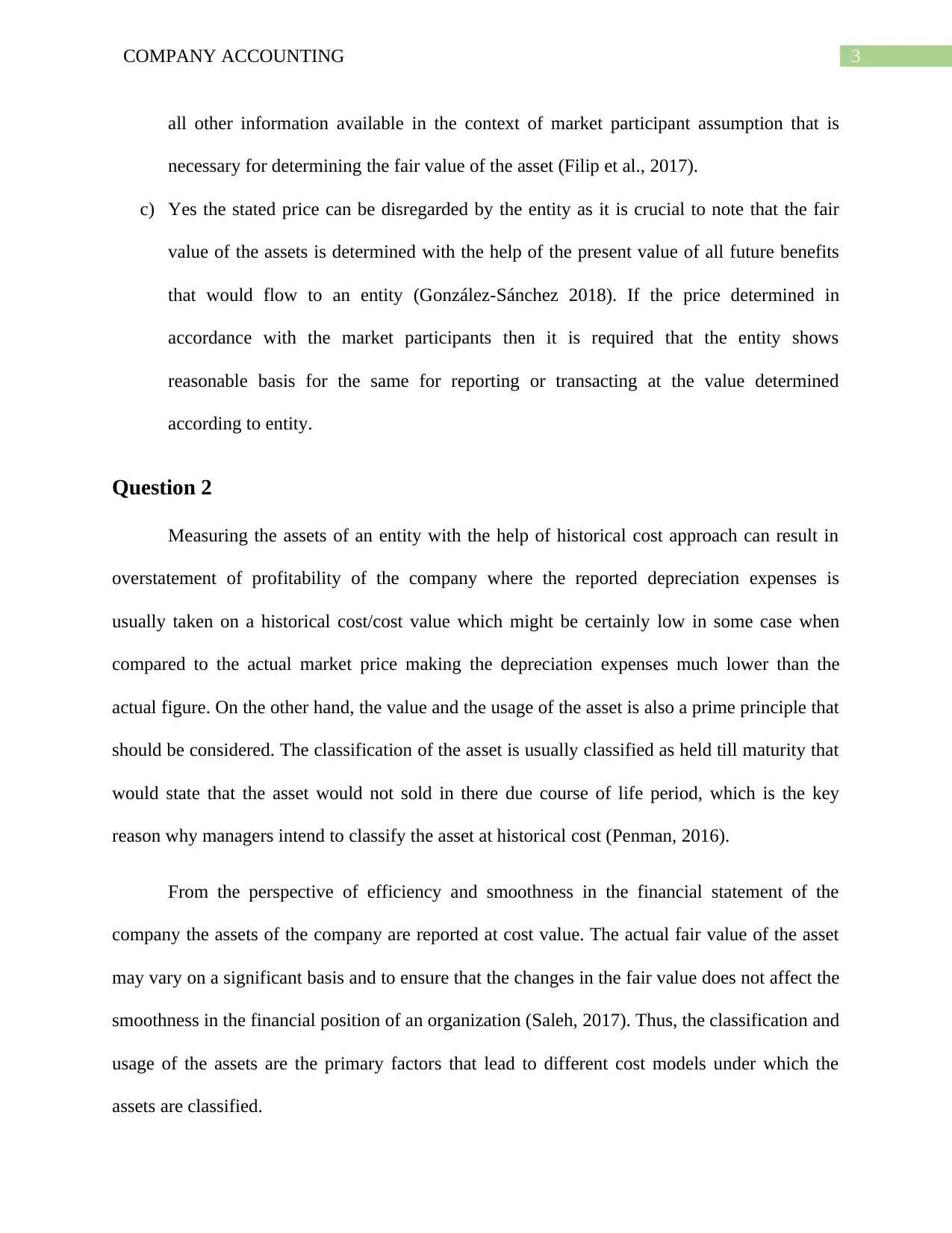
3COMPANY ACCOUNTING
all other information available in the context of market participant assumption that is
necessary for determining the fair value of the asset (Filip et al., 2017).
c) Yes the stated price can be disregarded by the entity as it is crucial to note that the fair
value of the assets is determined with the help of the present value of all future benefits
that would flow to an entity (González-Sánchez 2018). If the price determined in
accordance with the market participants then it is required that the entity shows
reasonable basis for the same for reporting or transacting at the value determined
according to entity.
Question 2
Measuring the assets of an entity with the help of historical cost approach can result in
overstatement of profitability of the company where the reported depreciation expenses is
usually taken on a historical cost/cost value which might be certainly low in some case when
compared to the actual market price making the depreciation expenses much lower than the
actual figure. On the other hand, the value and the usage of the asset is also a prime principle that
should be considered. The classification of the asset is usually classified as held till maturity that
would state that the asset would not sold in there due course of life period, which is the key
reason why managers intend to classify the asset at historical cost (Penman, 2016).
From the perspective of efficiency and smoothness in the financial statement of the
company the assets of the company are reported at cost value. The actual fair value of the asset
may vary on a significant basis and to ensure that the changes in the fair value does not affect the
smoothness in the financial position of an organization (Saleh, 2017). Thus, the classification and
usage of the assets are the primary factors that lead to different cost models under which the
assets are classified.
all other information available in the context of market participant assumption that is
necessary for determining the fair value of the asset (Filip et al., 2017).
c) Yes the stated price can be disregarded by the entity as it is crucial to note that the fair
value of the assets is determined with the help of the present value of all future benefits
that would flow to an entity (González-Sánchez 2018). If the price determined in
accordance with the market participants then it is required that the entity shows
reasonable basis for the same for reporting or transacting at the value determined
according to entity.
Question 2
Measuring the assets of an entity with the help of historical cost approach can result in
overstatement of profitability of the company where the reported depreciation expenses is
usually taken on a historical cost/cost value which might be certainly low in some case when
compared to the actual market price making the depreciation expenses much lower than the
actual figure. On the other hand, the value and the usage of the asset is also a prime principle that
should be considered. The classification of the asset is usually classified as held till maturity that
would state that the asset would not sold in there due course of life period, which is the key
reason why managers intend to classify the asset at historical cost (Penman, 2016).
From the perspective of efficiency and smoothness in the financial statement of the
company the assets of the company are reported at cost value. The actual fair value of the asset
may vary on a significant basis and to ensure that the changes in the fair value does not affect the
smoothness in the financial position of an organization (Saleh, 2017). Thus, the classification and
usage of the assets are the primary factors that lead to different cost models under which the
assets are classified.
Paraphrase This Document
Need a fresh take? Get an instant paraphrase of this document with our AI Paraphraser
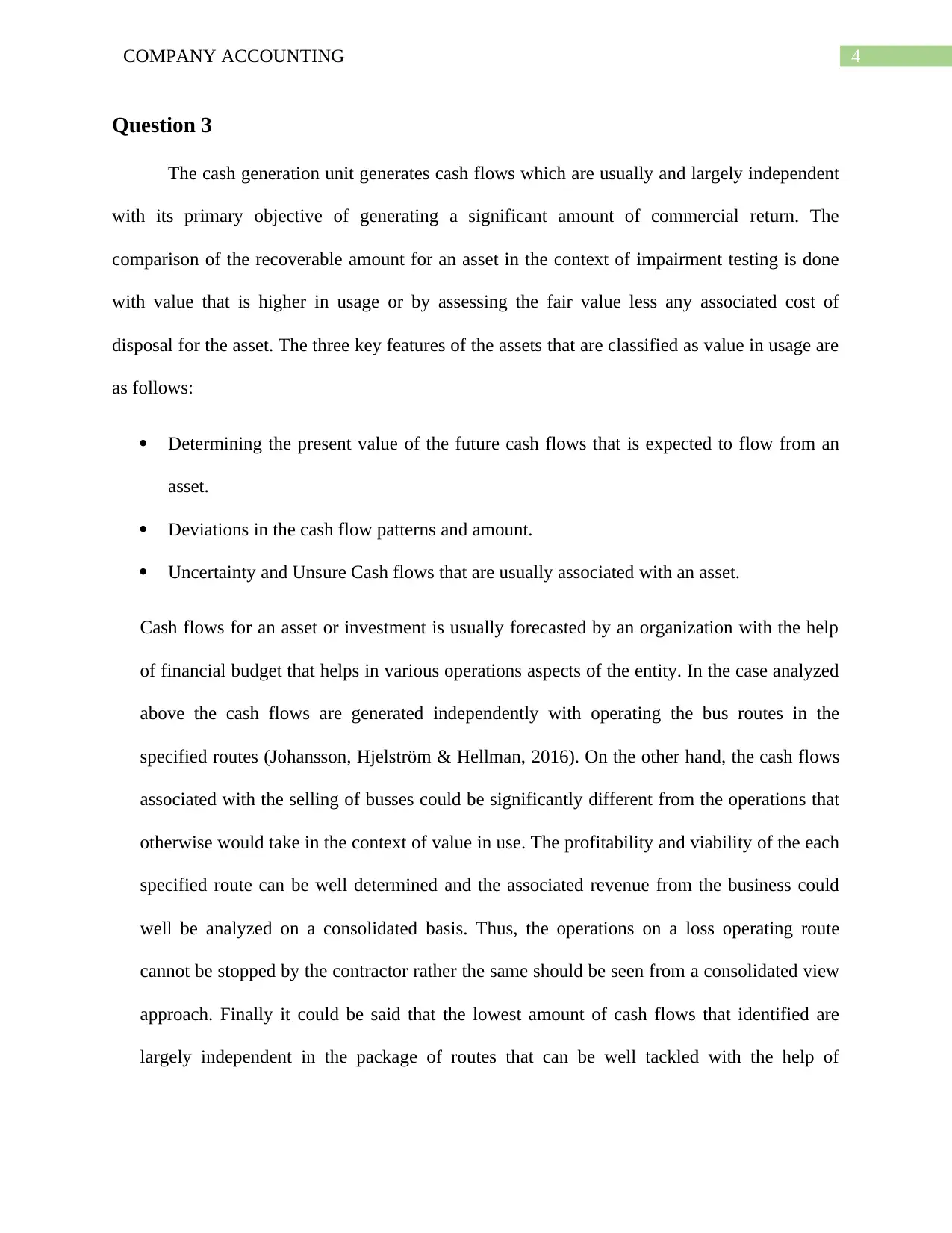
4COMPANY ACCOUNTING
Question 3
The cash generation unit generates cash flows which are usually and largely independent
with its primary objective of generating a significant amount of commercial return. The
comparison of the recoverable amount for an asset in the context of impairment testing is done
with value that is higher in usage or by assessing the fair value less any associated cost of
disposal for the asset. The three key features of the assets that are classified as value in usage are
as follows:
Determining the present value of the future cash flows that is expected to flow from an
asset.
Deviations in the cash flow patterns and amount.
Uncertainty and Unsure Cash flows that are usually associated with an asset.
Cash flows for an asset or investment is usually forecasted by an organization with the help
of financial budget that helps in various operations aspects of the entity. In the case analyzed
above the cash flows are generated independently with operating the bus routes in the
specified routes (Johansson, Hjelström & Hellman, 2016). On the other hand, the cash flows
associated with the selling of busses could be significantly different from the operations that
otherwise would take in the context of value in use. The profitability and viability of the each
specified route can be well determined and the associated revenue from the business could
well be analyzed on a consolidated basis. Thus, the operations on a loss operating route
cannot be stopped by the contractor rather the same should be seen from a consolidated view
approach. Finally it could be said that the lowest amount of cash flows that identified are
largely independent in the package of routes that can be well tackled with the help of
Question 3
The cash generation unit generates cash flows which are usually and largely independent
with its primary objective of generating a significant amount of commercial return. The
comparison of the recoverable amount for an asset in the context of impairment testing is done
with value that is higher in usage or by assessing the fair value less any associated cost of
disposal for the asset. The three key features of the assets that are classified as value in usage are
as follows:
Determining the present value of the future cash flows that is expected to flow from an
asset.
Deviations in the cash flow patterns and amount.
Uncertainty and Unsure Cash flows that are usually associated with an asset.
Cash flows for an asset or investment is usually forecasted by an organization with the help
of financial budget that helps in various operations aspects of the entity. In the case analyzed
above the cash flows are generated independently with operating the bus routes in the
specified routes (Johansson, Hjelström & Hellman, 2016). On the other hand, the cash flows
associated with the selling of busses could be significantly different from the operations that
otherwise would take in the context of value in use. The profitability and viability of the each
specified route can be well determined and the associated revenue from the business could
well be analyzed on a consolidated basis. Thus, the operations on a loss operating route
cannot be stopped by the contractor rather the same should be seen from a consolidated view
approach. Finally it could be said that the lowest amount of cash flows that identified are
largely independent in the package of routes that can be well tackled with the help of
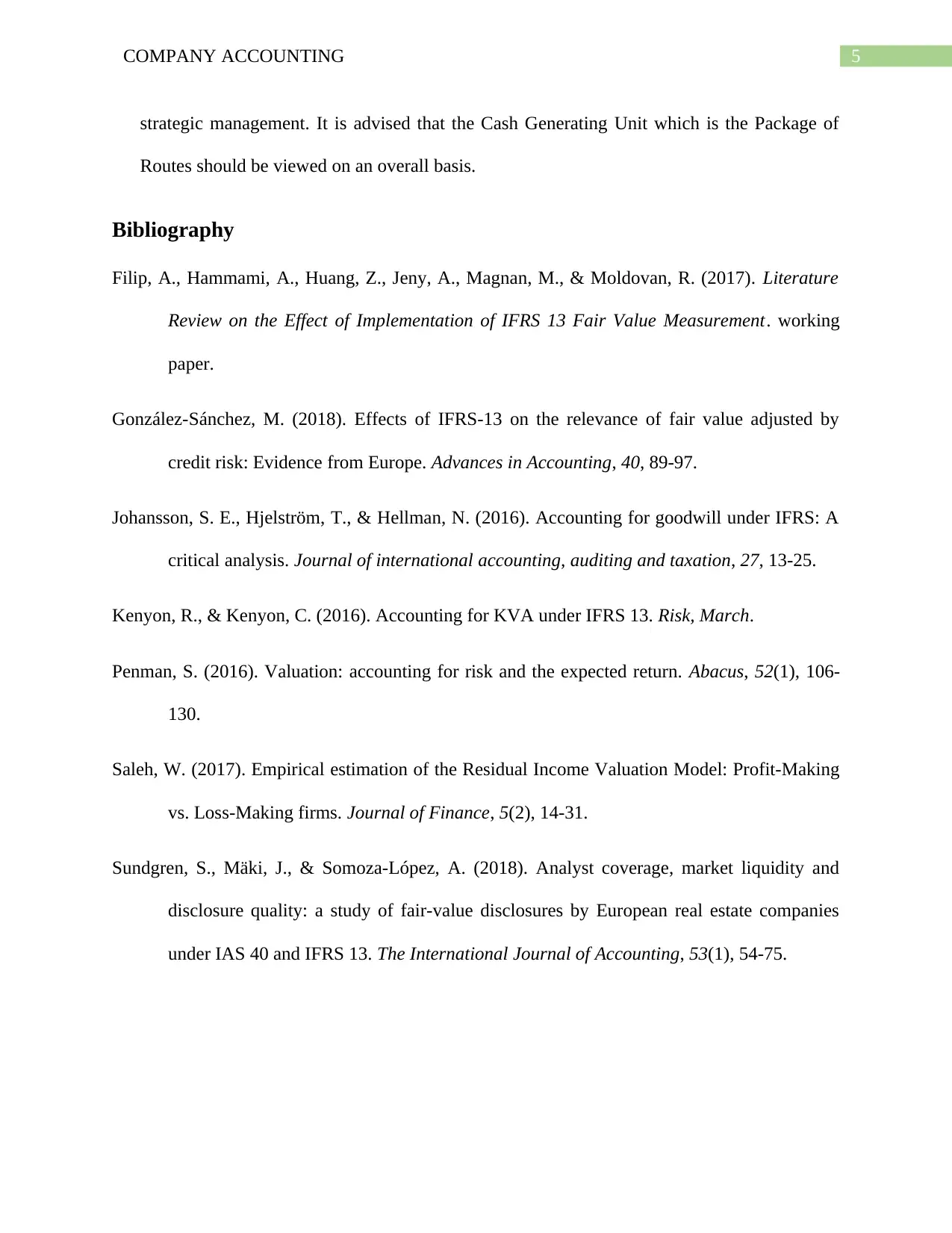
5COMPANY ACCOUNTING
strategic management. It is advised that the Cash Generating Unit which is the Package of
Routes should be viewed on an overall basis.
Bibliography
Filip, A., Hammami, A., Huang, Z., Jeny, A., Magnan, M., & Moldovan, R. (2017). Literature
Review on the Effect of Implementation of IFRS 13 Fair Value Measurement. working
paper.
González-Sánchez, M. (2018). Effects of IFRS-13 on the relevance of fair value adjusted by
credit risk: Evidence from Europe. Advances in Accounting, 40, 89-97.
Johansson, S. E., Hjelström, T., & Hellman, N. (2016). Accounting for goodwill under IFRS: A
critical analysis. Journal of international accounting, auditing and taxation, 27, 13-25.
Kenyon, R., & Kenyon, C. (2016). Accounting for KVA under IFRS 13. Risk, March.
Penman, S. (2016). Valuation: accounting for risk and the expected return. Abacus, 52(1), 106-
130.
Saleh, W. (2017). Empirical estimation of the Residual Income Valuation Model: Profit-Making
vs. Loss-Making firms. Journal of Finance, 5(2), 14-31.
Sundgren, S., Mäki, J., & Somoza-López, A. (2018). Analyst coverage, market liquidity and
disclosure quality: a study of fair-value disclosures by European real estate companies
under IAS 40 and IFRS 13. The International Journal of Accounting, 53(1), 54-75.
strategic management. It is advised that the Cash Generating Unit which is the Package of
Routes should be viewed on an overall basis.
Bibliography
Filip, A., Hammami, A., Huang, Z., Jeny, A., Magnan, M., & Moldovan, R. (2017). Literature
Review on the Effect of Implementation of IFRS 13 Fair Value Measurement. working
paper.
González-Sánchez, M. (2018). Effects of IFRS-13 on the relevance of fair value adjusted by
credit risk: Evidence from Europe. Advances in Accounting, 40, 89-97.
Johansson, S. E., Hjelström, T., & Hellman, N. (2016). Accounting for goodwill under IFRS: A
critical analysis. Journal of international accounting, auditing and taxation, 27, 13-25.
Kenyon, R., & Kenyon, C. (2016). Accounting for KVA under IFRS 13. Risk, March.
Penman, S. (2016). Valuation: accounting for risk and the expected return. Abacus, 52(1), 106-
130.
Saleh, W. (2017). Empirical estimation of the Residual Income Valuation Model: Profit-Making
vs. Loss-Making firms. Journal of Finance, 5(2), 14-31.
Sundgren, S., Mäki, J., & Somoza-López, A. (2018). Analyst coverage, market liquidity and
disclosure quality: a study of fair-value disclosures by European real estate companies
under IAS 40 and IFRS 13. The International Journal of Accounting, 53(1), 54-75.
⊘ This is a preview!⊘
Do you want full access?
Subscribe today to unlock all pages.

Trusted by 1+ million students worldwide

6COMPANY ACCOUNTING
1 out of 7
Related Documents
Your All-in-One AI-Powered Toolkit for Academic Success.
+13062052269
info@desklib.com
Available 24*7 on WhatsApp / Email
![[object Object]](/_next/static/media/star-bottom.7253800d.svg)
Unlock your academic potential
Copyright © 2020–2025 A2Z Services. All Rights Reserved. Developed and managed by ZUCOL.





